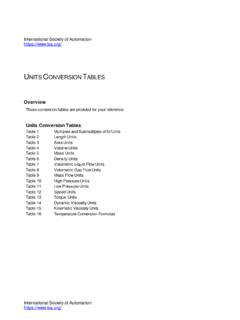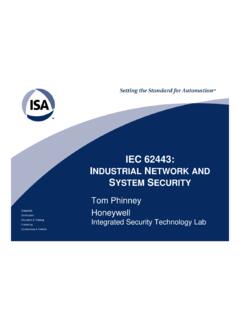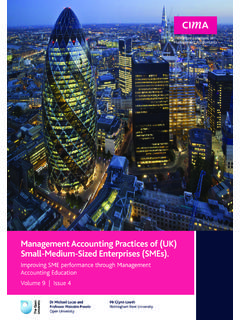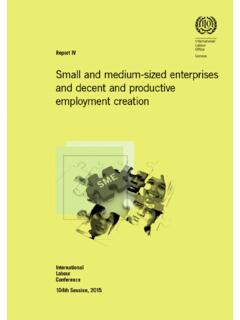Transcription of WHITE PAPER - ISA
1 1 WHITE PAPERS tandardsCertificationEducation & TrainingPublishingConferences & ExhibitsIndustrial Cybersecurityfor small - and medium - sized BusinessesA Practical GuideInternational Society of AutomationCopyright ISA, All Rights ReservedIndustrial Cybersecurity for small - and medium - sized BusinessesA Practical GuideExecutive Summary ..5 Why Cybersecurity Management is Important ..6 Protecting businesses from the impact of a cybersecurity incident ..6 Risk Assessment ..7 Common threats ..7 Common vulnerabilities and key mitigations ..8 Potential consequences of inadequate cybersecurity management ..11 Essential cybersecurity activities ..13 Identify ..14 Create an inventory of all IT and OT assets ..14 Assess the risk of a cyber incident ..14 Define a cybersecurity management policy ..14 Protect ..15 Secure network and equipment ..15 Protect sensitive information.
2 15 Manage access to systems and equipment ..16 Detect ..16 Define methods for monitoring ..16 Define responsibilities for monitoring ..16 Identify improvements ..16 Respond ..17 Maintain incident response plan ..17 Practice response processes ..17 Identify improvements ..17 Recover ..17 Maintain backups of all systems and equipment ..17 Practice recovery processes ..17 Identify improvements ..17 Awareness and training ..18 Assessment and continuous improvement ..18 Self assessment ..18 Third-party assessment ..18 Continuous improvement ..18 References and further reading ..19 ContentsIndustrial Cybersecurity for small - and medium - sized BusinessesA Practical Guide5 Effective cybersecurity management is essential for all organizations, regardless of size. There are many standards and guidance documents available to help organizations determine a way document is intended to provide a starting point for small - and medium -businesses (SMBs), particularly those that manage industrial processes and employ some level of automation.
3 Specific examples include SMBs in the chemical and water and wastewater treatment it is generally accepted that Operational Technol-ogy (OT) system security requires different or additional measures than general-purpose Information Technology (IT) system security, it is also true that smaller companies might have difficulty implementing much of the available and practices are often based on the assumption that engineering and operations resources are available to define, implement, and monitor the technology, busi-ness processes, and associated controls. Unfortunately, this is often not the case. Smaller operations are typically not staffed to include such roles. It is more common to have broadly defined staff roles, with support and operation of IT systems as only part of an individual s responsibilities. Smaller companies may not even be fully aware of the risks they face or that they can contract for cybersecurity-related services.
4 This guide is intended to identify the essential controls that need to be need to understand their cybersecurity risk and to take action to reduce this risk, just as they do with other business risks. The absence of previous incidents, or the belief that the organization is not a likely target, is not sufficient justification for ignoring this can be at risk from a wide variety of threats, including amateur and professional hackers, environmental activists, disgruntled employees or contractors and even nation states or terrorists. In addition, many cybersecurity incidents are a result of accidents or unintentional actions. A com-pany does not have to be a specific target to be consequence to an SMB can vary tremendously based on the nature of operations and the vulnerabilities of each. It is essential that the underlying vulnerabilities are recognized and that these vulnerabilities be mitigat-ed to minimize the likelihood of potentially dire document provides guidance based on well-established frameworks and standards.
5 Further reference should be made to these frameworks and standards, focusing on the recommendations in this management is not a one-time activity. Like quality and safety management, cybersecurity management is an ongoing activity where continuous improvement must be made in order to manage the SummaryIndustrial Cybersecurity for small - and medium - sized BusinessesA Practical Guide6 Why Cybersecurity Management is ImportantProtecting businesses from the impact of a cybersecurity incidentVery few, if any, businesses today operate without some dependence on systems and equipment that are vulnerable to a cybersecurity incident. The impact to the business of such an incident will vary. However, this impact needs to be understood and managed accordingly if businesses are to be able to operate as are two broad categories of systems and equipment.
6 Information Technology (IT) and Operational Technology (OT), each with their own characteristics, as shown in the table Technology (IT)Operational Technology (OT)DefinitionUsed in a business or office environment to support day-to-day activities, such as account-ing, ordering, human resources, and data to monitor and control processes in industrial environments, such as factory floors, refineries, oil and gas platforms, and water treatment of systems or equipment User workstations or laptops File-, email-, or web-servers Databases Network devices (routers, firewalls, switches) Programmable Logic Controllers (PLCs) Distributed Control Systems (DCSs) Supervisory Control And Data Acquisition (SCADA) systems Historian databases Protocol and media convertersCybersecurity concernsData confidentiality is the primary concern, followed by integrity of the data and system availability is the primary concern, followed by integrity of the data, and finally, data confidentiality.
7 In OT, data integrity and confidentiality are particu-larly important for device logic or configuration files used in control applications. Management of ChangeChange-control processes are largely self-contained within the IT changes are part of the overall Management of Change process. It can be difficult to take equipment out of service to factors It is becoming more common for employees to use their own devices, especially mobile technology, to access business systems New technologies are being adopted with insufficient concern for security Equipment and communications protocols tend to be proprietary, and it can be difficult to implement typical cybersecurity controls Underlying technology can be antiquated and, therefore, more vulnerable to basic cybersecurity incidents The equipment environment is almost always heterogeneous, with devices of various ages and sourcesIndustrial Cybersecurity for small - and medium - sized BusinessesA Practical Guide7 Risk AssessmentCybersecurity-related risks are evaluated using a process that.
8 Systematically identifies potential vulnerabilities to valu-able system resources and threats to those resources; quantifies loss exposures and consequences based on probability of occurrence; and (optionally) recommends how to allocate resources to countermeasures to minimize total simple terms, risk can be defined as a function of threat, vulnerability, and consequence. Each of these elements must be assessed in order to gain a full understanding of the threatsWhen considering cybersecurity threats, many consider only deliberate, targeted attacks from professional hackers. As a result, some dismiss the risk to their facilities. The table below shows that SMBs are subject to numerous types of threats, both deliberate and otherwise. Cyber-security incidents can arise as a result of accidents or unintentional actions by authorized individuals (employees, vendors, or contractors).
9 Many threats are often non-targeted and SMBs can be impacted as collateral all of the examples below, SMBs could be impacted indirectly, simply because they have equipment similar to the primary 1 Threat ExamplesThreatDescriptionExampleAmateur hackersWith access to many online tools and resources, anyone can find systems con-nected to the Internet and interfere with their operation, often for the challenge or online community is a popular forum for amateur hackers, and is believed to be behind the PlayStation network attack on Christmas Day 2014, as well as the attack on the Internet Name Servers in the Eastern USA in October hackersHackers with more skills and resources target organizations with ransom ware and other disruptive techniques and tools for 2016, the Lansing Board of Water & Light was forced to pay a $25,000 ransom to unlock its internal communications systems, which were hit as part of a larger attack.
10 The utility estimated the total cost of responding to the attack and strengthening its defenses against future attacks was $ activistsGroups can work with hackers to disrupt the operations of organizations whose business practices they oppose or are contrary to their 2011, the group Anonymous posted confidential information on 2,500 Monsanto employees and associates and shut down the company s international websites for nearly three employees or contractorsUsing inside knowledge or privileged access, to gain revenge by disrupting operations or to steal confidential infor-mation to be sold to competitorsIn 2012, a male programmer passed over for promo-tions at a Long Island power supply manufacturer created an unauthorized program to harvest employees logins and leaving the company, the person used his creden-tials to get into the network and disrupt business and inflict damage on the company s Cybersecurity for small - and medium - sized BusinessesA Practical Guide8 ThreatDescriptionExampleNation states or terroristsOrganizations with very large resources target critical infrastructure organizations to create instability or to influence their 2010, a virus known as Stuxnet compromised Iran s nuclear enrichment facility.















